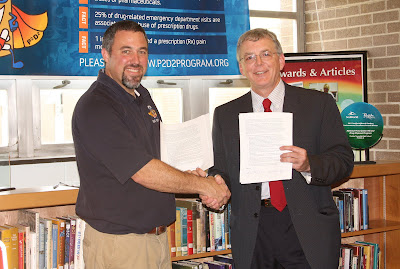Illinois-Indiana Sea Grant won two APEX 2011 Awards for Publication Excellence, both in the category Green Materials. Irene Miles, communication coordinator, and Susan White, graphic designer, won for the IISG impact statement series titled Impacts: Today and Tomorrow. These four publications describe the program’s success stories and ongoing projects related to aquatic invasive species, unused medicines, land use planning, and water resources.
The second APEX award goes to Robin Goettel, associate director for education, for the 4-H curriculum Sensible Disposal of Unwanted Medicines. This booklet provides five inquiry-based lessons to help high school youth understand the harmful effects of improper disposal of medicines and what they can do to help. Robin shares this award with Natalie Carroll of Purdue University Extension, Whitney Siegfried, who is now at the University of South Dakota, and Deb Eisenmann, a freelance designer.
From Great Lakes Echo:
Before the wells dry up and the sewers overflow, a northwest Chicago suburb has teamed up with an all-star squad of planners to guide future water policy and use.
The small village of Lake Zurich gets drinking water from an aquifer that is pumped faster than it can recharge, according to studies. The water also has low levels of radium, which means treatment and extra costs for the village.
And the village’s sewer system is strained to capacity, stirring fears of a double digit sewage rate increase to fix the problem, said Rich Sustich, village trustee, who is spearheading the water planning effort.
“When you have this nexus of issues like we have – drinking water, storm water and wastewater, it forces out-of-the-box thinking,” Sustich said.
In January, Illinois approved Lake Zurich and nine other communities in the northeastern part of the state to tap Lake Michigan for water because of growing concern that the groundwater they use now will dry up. Studies indicate that population and economic growth will cause water use to increase even if conservation measures are taken.
Lake Zurich is not ruling out sticking a straw into Lake Michigan, but has decided to take a more calculated approach.
“Most people don’t realize that there are substantial costs to get drinking water from Lake Michigan,” Sustich said. “You don’t just tap right in.” Read more.
From our latest issue of The HELM:
In Lake Zurich, a northwest Chicago suburb, leaders are looking at their current water situation as a glass that is half full. This Lake County village is in the process of deciding what will be its future water source because continuing to pump from its deep aquifer is not sustainable.
“Some people think of these issues as challenges; I think of them as opportunities,” said village Trustee Richard Sustich, who is spearheading the water initiative.
On March 7, the Lake Zurich Village Board signed a memorandum that approved hiring an integrated water resources management team to advise the community as it develops its future water plan. The team will assist the village with the engineering, cost, and analysis of the different water options.
The Metropolitan Planning Councilis leading the team, which also consists of Illinois-Indiana Sea Grant, the Chicago Metropolitan Agency for Planning, and the Center for Neighborhood Technology. Read more.
From the New York Times:
Thomas Simon remembers the day he found a carp in the Grand Calumet River in 1985, barely alive, bloody and with no fins. “It looked like someone had beaten it up,” said Mr. Simon, a biologist who studied the river for 26 years.
Yet state officials were thrilled, because it was the first fish found in years in the northwest Indiana river that is widely considered the nation’s most toxic waterway.
A quarter century later, fish are more plentiful and look healthy. But state and federal agencies say they are still unsafe to eat, their flesh laced with toxins from sediment poisoned by decades of dumping from nearby steel mills, chemical plants, meatpacking operations and other industries. Read more.
From the Chicago Tribune:
As beaches officially open this weekend, health officials are using cutting-edge computer systems, frequent water testing and even specially trained dogs to monitor water quality and keep Lake Michigan safe for swimming.
Communities across the country traditionally have relied on testing water samples to determine if there are dangerous levels of bacteria. The tests can take up to 24 hours to process, however, forcing officials to decide whether to ban swimming based on day-old data.
But new technology is beginning to slash that lag time, allowing health officials to analyze results more quickly and accurately. Read more.
From National Geographic:
When antidepressant pills get flushed down the drain, they do more than create happier sewers.
Scientists in Erie, Pennsylvania, have found that minute concentrations of fluoxetine, the active ingredient in Prozac, are killing off microbial populations in the Great Lakes.
Traces of antidepressants such as Prozac have been found in both drinking and recreational water supplies throughout the world, in quantities experts say are too dilute to affect humans but which have been found to damage the reproductive systems of mollusks and may even affect the brains of animals like fish. Read more.
The Lawn to Lake program promotes healthy landscape practices, offering communities, landscapers, residents, and others, tips for maintaining healthy lawns and landscapes without over-relying on chemicals. This new Lawn to Lake factsheet, What’s in Your Watershed?, explains exactly what a watershed is—simply, the area of land that drains to a specific body of water—and more. The focus is Indiana and the six coastal watersheds that have a direct impact on the water quality and quantity of Lake Michigan. The factsheet also gives advice on how protect watersheds by reducing fertilizer inputs.
From the New York Times:
The Windy City is preparing for a heat wave — a permanent one.
Climate scientists have told city planners that based on current trends, Chicago will feel more like Baton Rouge than a Northern metropolis before the end of this century.
So, Chicago is getting ready for a wetter, steamier future. Public alleyways are being repaved with materials that are permeable to water. The white oak, the state tree of Illinois, has been banned from city planting lists, and swamp oaks and sweet gum trees from the South have been given new priority. Thermal radar is being used to map the city’s hottest spots, which are then targets for pavement removal and the addition of vegetation to roofs. And air-conditioners are being considered for all 750 public schools, which until now have been heated but rarely cooled. Read more.
What could have been a dry event was injected with humor when Illinois-Indiana Sea Grant and the National Prescription Drug Disposal Program (P2D2) signed a memorandum of understanding May 10 at Pontiac Township High School (PTHS). Much to the surprise and delight of the people attending, National P2D2 Coordinator and PTHS teacher Paul Ritter dressed like the program’s mascot, superhero Pill Bottle Phil, while tossing P2D2 T-shirts to students.
“In a lot of ways, Ritter is really a superhero kind of guy,” said IISG Director Brian Miller, who co-signed the document. “He’s been traveling all over the country, and it seems like he can be everywhere at once.”
The purpose of P2D2 is to provide communities with a proper method of pharmaceutical disposal that effectively reduces the misuse and abuse of pharmaceuticals as well as improves water quality.
IISG has been working with P2D2 for several years, but signing the MOU officially recognizes the partnership. IISG provides P2D2 with information and helps fund tools for the program, including drug drop boxes, billboard space, and brochures. IISG also produced The Medicine Chest, a compendium of classroom activities, many developed through the P2D2 program.
Many PTHS students and teachers have been integral to the program, and teacher Megan Bozarth’s junior and senior social studies class work closely with P2D2. The students have also been promoting Illinois House Bill 2056, which would create a special fund for pharmaceutical collection and disposal by establishing a $20 fine for people who commit specified drug offenses. If passed, the bill would also provide funding for Illinois police departments to establish pharmaceutical take-back programs so people can properly dispose of their unwanted medicines.
“It’s been amazing to watch how far this has gone,” Miller said.
Also at the signing was Pollution Prevention Program Specialist Laura Kammin, who also serves as IISG’s direct contact with P2D2. “Both IISG and P2D2 work to help communities legally dispose of unused medicines in ways that protect humans, pets, wildlife, and the environment,” Kammin said. “Working together, we can accomplish much more than when we work alone. This is an exciting day for both programs.”
Many of the students spoke at the signing, including Trevor Ross, Kendra Warren, Alex Borgstrom, Debi Johnson, Nora McCune, Beth Guilde, and Tiffany Patterson.
“P2D2 is life changing,” Johnson said. “This program protects our environment, keeps our water clean, and prevents anyone from using these unused drugs and dying from them. This will help make our world a little greener.”
Ritter praised the students, saying they were responsible for more than 145,000 pounds of pharmaceuticals being disposed of properly in Illinois.“We are talking about two semi tractor-trailers full of pharmaceuticals,” Ritter said. “You guys have changed people’s lives in ways that we’ll never actually know if we do our job right.”






